Financial markets wobbled prior to the Federal Reserve Open Market Committee meeting last week even though no one was expecting a surprise outcome. And indeed, the FOMC did not disappoint, adding 25 basis points to the fed funds rate and taking it to 5.25 percent. Of the major central banks, only the Reserve Bank of Australia now has a higher rate - 5.75 percent.

After equivocating all week, equities turned positive on Thursday, pushing away growth and interest rate fears. With little fresh economic data early in the week, caution was investors' byword as they awaited the Fed's announcement and statement. And the equity markets (those that were open when the announcement was made) rejoiced upon reading the Fed's statement. But the dollar sank like a rock.
Some economists said both the structure and language of the microscopically-parsed statement appeared to be more dovish than recent comments by Fed officials. The statement acknowledged that economic growth was moderating from its earlier rapid pace reflecting the slower housing market along with the lagged impact of earlier interest rate increases and energy prices. Though over time some inflation risks remain, the statement also said that slower growth should help limit inflationary pressures. This added to doubts in investors' minds about an increase at the next FOMC meeting on August 8th.
In the first six months, equity indexes worldwide paralleled each other's performance - the higher they rose, the further they fell. The second quarter was particularly bad for equities. Of the 13 indexes followed here, only the Dow (barely) and Hang Seng managed to record a gain in the second quarter. And the Nikkei, Topix, Kospi and Nasdaq were lower than their end of 2005 levels.
Global Stock Market Quarterly Recap

Europe and the UK
After vacillating for three days, European and UK stocks enjoyed two days of hefty gains. On Thursday investor fears about an aggressive move by the Federal Reserve seemed to evaporate. And in Europe, industrial engineering stocks rallied after German manufacturing orders data boosted confidence. In a catch up release after the end of a strike in North-Rhine Westfalia (data were first available for February, March and April), orders were up by 4.1 percent in April, the biggest increase since the end of 2004. Even though foreign orders continued to be the main driver, there was steady growth in domestic orders as well, also positive news.
All three indexes ended the week on the plus side. However, the FTSE, CAC and DAX were down on the quarter. During the second quarter they managed to achieve both their highs and their lows for the year. But the indexes managed to recover from their early June lows, and remain above 2005 year end levels.

According to Organisation for Economic Cooperation and Development (OECD) the UK received more inward investment in 2005 than any other country in its membership as global foreign direct investment (FDI) reached a four-year high, buoyed by a wave of mergers and acquisitions. But the OECD warned for the first time that investment and growth were threatened by "knee-jerk" reactions against takeovers, based on national security concerns and a sense that not all countries and their companies play by the same rules. Foreign direct investment into OECD countries increased by 27 percent with mergers and acquisitions accounting for more than half of FDI in most OECD countries. Outside the OECD, China hit a record as a destination for FDI, with inflows surpassed only by the UK and U.S.
Asia/Pacific
Asian stocks had their biggest gain since May 2004 on Friday after the Federal Reserve signaled it may end a two-year run of interest-rate increases. Consumer product companies such as Toyota Motor Corp. and Samsung benefited. The Fed said U.S. economic growth was moderating and this sparked the biggest rally since 2003. BHP Billiton and Sumitomo Metal Mining Co. led materials stocks higher. In Japan, the Nikkei soared on domestic news that included a plethora of new economic data that were released. The data for May CPI showed prices increasing at the fastest pace in eight years, and another release showed a drop in the jobless rate to an eight-year low of 4 percent adding to evidence deflation is down for the count as wage growth accelerates.

As in Europe and the UK, Asian stocks experienced the highs and lows for the year during the second quarter. But unlike those indexes, three of the six indexes followed here - the Nikkei, Topix and Kospi - are now below their end of 2005 levels. The Nikkei lagged both Europe and the U.S. significantly as shares were hit by concerns over tightening monetary policy and continued doubts over the extent of recovery in the Japanese economy. Only the Hang Seng managed to avoid the gravitational pull and ended the quarter up 2.9 percent. Along with the Hang Seng, the all ordinaries and STI remain up for the first six months of 2006.
North America
The most striking performance of the four indexes followed here has been by the Bolsa. It soared the highest and consequently sank the most in the second quarter. The index benefited from investors' attraction to emerging markets earlier in the year and then dropped as investors became risk averse. Also playing on the index has been the long drawn out election campaign for president that culminates on Sunday, July 2nd. The Dow fared better than its Canadian and Mexican counterparts. The Dow was up in the second quarter - the Nasdaq was down on the quarter and was below its end of 2005 level as well.

Currencies
Currencies also played a waiting game for the Fed last week. After gaining slightly earlier in the week, the dollar sank after the Fed's announcement and continued to drop on Friday. The losses were prompted by expectations that U.S. interest rates would soon stop climbing after two years of steady increases while those in Europe and Japan are slated to go up. But the après meeting statement was less hawkish on inflation than many currency market participants had anticipated. This sent the dollar, which was near a two-month high against the euro, to a three-week low. Even though inflation remained a concern, the FOMC put more emphasis on moderating growth conditions.

Indicator scoreboard
EMU - M3 for the three months ending in May was up 8.7 percent when compared with the same three months in 2005. This is far above the ECB's money supply target of 4.5 percent. May M3 was up by 8.9 percent on the year while private loan growth soared by 11.4 percent.

June flash harmonized index of consumer prices was up 2.5 percent for the second month when compared with last year and remains above the ECB's target of 2 percent on the year. As in all flash reports, no detail was available.

EU - June economic sentiment survey climbed to 107.2 from 106.7 in the prior month. This is the highest level in almost five years. Gains in the smaller countries more than offset declines in Germany, France and Spain. Industrial sentiment increased to plus 3 from positive 2 in May. Consumer sentiment slipped to minus 8 from minus 7, but retail sentiment picked up to a reading of plus 3 from the previous minus 1 in May.

Germany - June Ifo confidence index jumped to 106.8 from 105.7 in May and the highest level in 15 years. Respondents were the most optimistic about their current condition since July 1991. They are also more positive about their business in six months time. Manufacturers and retailers led the increase. The survey is conducted by the Ifo Economic Research Institute in Munich and is based on a survey of 7,000 executives.

June seasonally adjusted unemployment rate edged down to 10.9 percent from 11 percent a month earlier. In the East, the rate declined to 17.2 percent from 17.5 percent a month earlier, while in the West the rate was 9.2 percent, down from 9.3 percent in May. The number of seasonally adjusted unemployed dropped by 49,000 for all of Germany with the West down 26,000 and the East down 23,000.

May total retail sales sank 2.6 percent and were down 2 percent when compared with last year. This virtually reversed all of April's gains. Sales in April had been up 2.1 percent and up 2.3 percent on the year. Excluding gasoline and auto sales, sales were down 2.2 percent.

France - Revised first quarter gross domestic product was up 0.5 percent and 1.5 percent when compared with the same quarter a year ago. Private consumption was up 0.8 percent while business investment was up a meager 0.2 percent on the quarter. Total domestic demand edged down 0.1 percent. Exports were up 0.9 percent while imports were up 0.6 percent.

May seasonally adjusted unemployment rate was 9.1 percent, down from 9.3 percent in April. The number of unemployed dropped by 45,000. Unemployment excludes jobseekers who did any work during the month as defined by the International Labour Organsation.

May producer price index was up 0.2 percent and 4.1 percent when compared with last year. Excluding food and energy, the PPI was up 0.3 percent and 1.9 percent on the year. Energy prices edged up by 0.2 percent but were still up a substantial 14.5 percent on the year. Food and agriculture prices were up 0.1 percent and 1.9 percent on the year.

UK - First quarter gross domestic product was revised upward to an increased of 0.7 percent and was up 2.3 percent when compared with the first quarter of 2005. The previous estimates were a 0.6 percent gain on the quarter and 2.2 percent gain on the year. In their annual revisions, ONS, the UK's statistics office, said that GDP growth had been revised upward in every year since 2001. The main reason for the most recent revision was stronger-than-estimated service sector growth. Industrial output was up 0.8 percent but down 0.9 percent on the year, with manufacturing output up 0.9 percent on the quarter but down 0.4 percent on the year. Household spending was up 0.3 percent and 1.5 percent on the year. Investment spending made a substantial contribution to growth and was up 1.4 percent and 5 percent on the year.
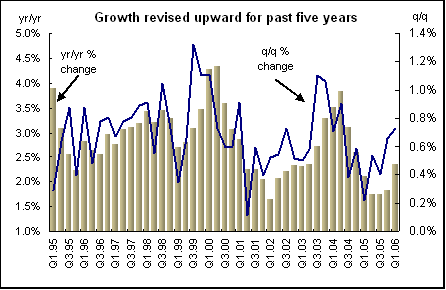
Asia
Japan - May retail sales were down 2.2 percent but up 0.1 percent when compared with the same month a year ago. Fuel sales jumped 7.1 percent on the year, reflecting in part a jump of 11 percent in gasoline prices. Electronic sales including flat-screen televisions and DVD recorders were up 0.4 percent on the year reflecting the World Cup effect. But clothing sales dropped 2.5 percent, cars slipped 2.4 percent and food and drink declined 1.1 percent. The retail sales report may understate consumption because it doesn't include services, which account for 60 percent of consumer spending. It also excludes new stores and internet sales.

May industrial production dropped 1 percent but was up 4.2 percent when compared with last year. The decline in part reflects production cuts by the makers of flat-screen panels and other consumer electronics after gearing up for demand for the soccer World Cup tournament. Aside from electronics, production for transport and electrical machinery was also down.
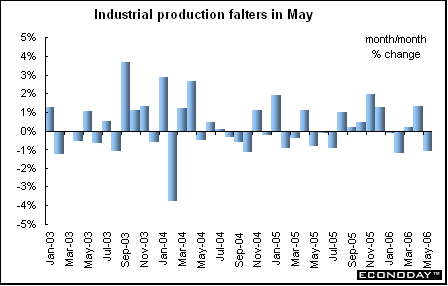
May unemployment rate edged down to 4 percent from 4.1 percent in the previous month. The number of unemployed has dropped by 300,000 from the same month a year ago. Employment was up by 130,000 on the year.
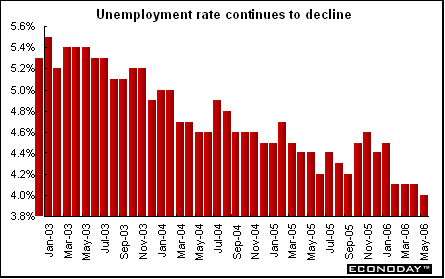
June Tokyo consumer price index was down 0.1 percent and was up 0.6 percent when compared with last year. Core CPI, which excludes only fresh food, was down 0.2 percent and up 0.3 percent on the year. May nationwide CPI was up 0.5 percent and 0.6 percent on the year. Core CPI was up 0.3 percent and 0.6 percent on the year.
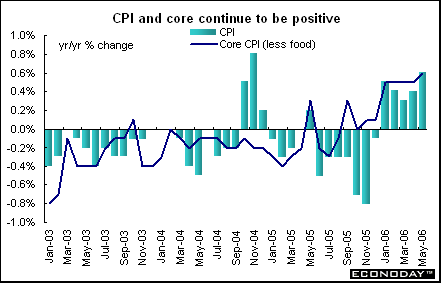
Americas
Canada - May industrial product price index (IPPI) was up 0.3 percent and 2.5 percent when compared with last year. Higher prices for primary metal products and petroleum products were the major contributors to the monthly increase. On the year, upward pressure came mainly from higher petroleum products and primary metal products prices.

May raw materials price index (RMPI) soared 5.6 percent following a 5.7 percent increase in April, due primarily to higher prices for crude oil and non-ferrous metals. When compared with last year, the RMPI was up 23.4 percent. Mineral fuels prices increased 6.7 percent while prices for crude oil were up by 7.8 percent, mainly due to continued concerns over supply. If mineral fuels had been excluded, the RMPI would have increased 4.5 percent instead of rising 5.6 percent. On the year, mineral fuels were up 27.2 percent with crude oil prices rising 31.1 percent and natural gas prices increasing 9.0 percent. If mineral fuels had been excluded, the RMPI would have increased 19.7 percent.
Between April and May, the value of the Canadian dollar against the U.S. dollar was up 3.1 percent. As a result, the total IPPI excluding the effect of the exchange would have risen 1.1 percent instead of its actual increase of 0.3 percent. On a 12-month basis, the value of the Canadian dollar rose 13.2 percent against the US dollar. If the impact of the exchange rate had been excluded, producer prices would have risen 5.8 percent between May 2005 and May 2006, rather than their actual increase of 2.5 percent.
April monthly gross domestic product edged upward by 0.1 percent and was up 3.1 percent when compared with April 2005. Services producing firms were up 0.3 percent with retailers climbing 1.2 percent thanks to sales of used cars and food & beverages. However, goods producing companies were down with electricity production declining 1 percent and construction, down 0.5 percent. Manufacturers account for about 17 percent of the overall economy.
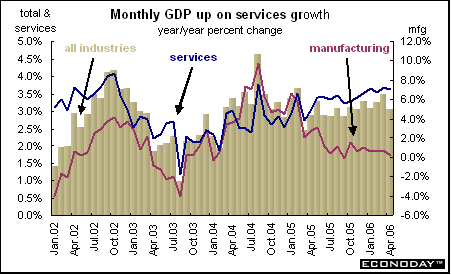
Bottom line
The first week of the month brings on the deluge of central bank meetings. The Reserve Bank of Australia will be first to announce on Wednesday morning in Australia (this translates to Tuesday night at 7:30 PM ET in the U.S.). It will be followed by the Bank of England and the European Central Bank announcements on Thursday morning. No action is expected in July. The RBA's current rate is 5.75 percent, the Bank of England's is 4.5 percent and the ECB's 2.75 percent. Only the RBA remains above the Federal Reserve's 5.25 percent fed funds rate.
Bank of England's governor Mervyn King testified in Parliament last week and signaled that the Bank is in no rush to increase interest rates despite a pick up in growth and a seven month high in inflation on increased energy costs. The monetary policy committee has kept the Bank's key interest rate at 4.5 percent for the past 10 months.
With no real dramatic moves expected, the markets will have to vie with the conclusion of the World Cup (and Wimbledon) for attention.

